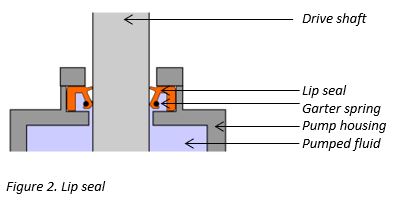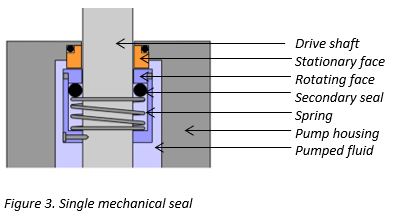Shaft seals prevent liquid escaping from a rotating or reciprocating shaft. This is important for all pumps and in the case of centrifugal pumps several sealing options will be available: packings, lip seals, and all types of mechanical seals-- single, double and tandem including cartridge seals. Rotary positive displacement pumps like gear pumps and vane pumps are available with packing, lip and mechanical seal arrangements. Reciprocating pumps pose different sealing problems and usually rely on lip seals or packings. Some designs, such as magnetic drive pumps, diaphragm pumps or peristaltic pumps, do not require shaft seals. These so-called 'sealless' pumps include stationary seals to prevent liquid leakage.
What are the main types of pump shaft seals?
Packing
Packing (also known as shaft packing or gland packing) consists of a soft material, which is often braided or formed into rings. This is pressed into a chamber around the drive shaft called the stuffing box to create a seal (Figure 1). Normally, compression is applied axially to the packing but it can also be applied radially by a hydraulic medium.
Traditionally, packing was made from leather, rope or flax but now usually consists of inert materials such as expanded PTFE, compressed graphite, and granulated elastomers. Packing is economical and commonly used for thick, difficult-to-seal liquids such as resins, tar or adhesives. However, it is a poor sealing method for thin liquids, especially at higher pressures. Packing seldom fails catastrophically, and it can be replaced quickly during scheduled shutdowns.
Packing seals require lubrication to avoid the build-up of frictional heat. This is usually provided by the pumped liquid itself which tends to leak slightly through the packing material. This can be messy and in the case of corrosive, flammable, or toxic liquids is often unacceptable. In these cases a safe, external lubricant may be applied. Packing is unsuitable for sealing pumps used for liquids containing abrasive particulates. Solids can become embedded in the packing material and this may then damage the pump shaft or stuffing box wall.

Lip seals
Lip Seals, also known as radial shaft seals, are simply circular elastomeric elements which are held in place against the drive shaft by a rigid outer housing (Figure 2). The seal arises from the frictional contact between the 'lip' and shaft and this is often reinforced by a spring. Lip seals are common throughout the hydraulic industry and can be found on pumps, hydraulic motors, and actuators. They often provide a secondary, backup seal for other sealing systems such as mechanical seals Lip seals are generally limited to low pressures and are also poor for thin, non-lubricating liquids. Multiple lip seal systems have been applied successfully against a variety of viscous, non-abrasive liquids. Lip seals are not suitable for use with any abrasive liquids or fluids containing solids as they are susceptible to wear and any slight damage can lead to failure.

Mechanical seals
Mechanical seals essentially consist of one or more pairs of optically flat, highly polished faces, one stationary in the housing and one rotating, connected to the drive shaft (Figure 3). The faces require lubrication, either by the pumped liquid itself or by a barrier fluid. In effect, the seal faces are only in contact when the pump is at rest. During use, the lubricating liquid provides a thin, hydrodynamic film between the opposing seal faces, reducing wear and aiding heat dissipation.

Mechanical seals can handle a wide range of liquids, viscosities, pressures, and temperatures. However, a mechanical seal should not be run dry. A key advantage of mechanical seal systems is that the drive shaft and casing are not part of the sealing mechanism (as is the case with packing and lip seals) and are not therefore subject to wear.
Double seals
Double seals utilise two mechanical seals positioned back to back (Figure 4). The space internal to the two sets of seal faces can be hydraulically pressurised with a barrier liquid so that the film on the seal faces necessary for lubrication will be the barrier liquid and not the medium being pumped. The barrier liquid must also be compatible with the pumped medium. Double seals are more complex to operate because of the need for pressurisation and are typically used only when it is necessary to protect personnel, external components and the surrounding environment from hazardous, toxic or flammable liquids.

Tandem seals
Tandem seals are similar to double seals but the two sets of mechanical seals face in the same direction rather than back-to-back. Only the product-side seal rotates in the pumped fluid but seepage across the seal faces eventually contaminates the barrier lubricant. This has consequences for the atmospheric side seal and surrounding environment.
Cartridge seals
A cartridge seal is a pre-assembled package of mechanical seal components. Cartridge construction eliminates installation issues such as the need to measure and set spring compression. Seal faces are also protected from damage during installation. In design, a cartridge seal can be a single, double or tandem configuration contained within a gland and built onto a sleeve.
Gas barrier seals.
These are cartridge-style dual seats with faces designed to be pressurised using an inert gas as a barrier, replacing the traditional lubricating liquid. Seal faces may be separated or held in loose contact during operation by adjusting the gas pressure. A small amount of gas may escape into the product and atmosphere.
Summary
Shaft seals prevent liquid escaping from a pump's rotating or reciprocating shaft. Often several sealing options will be available: packings, lip seals, and various types of mechanical seals-- single, double and tandem including cartridge seals.
